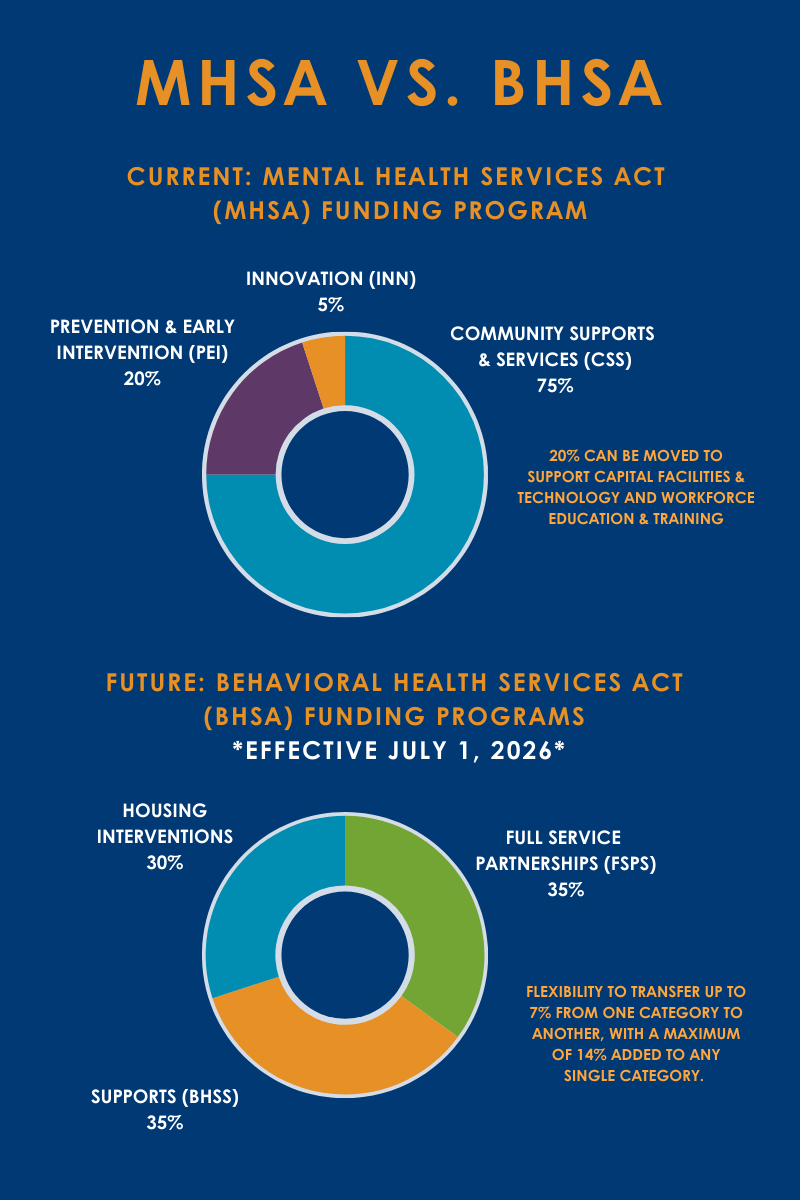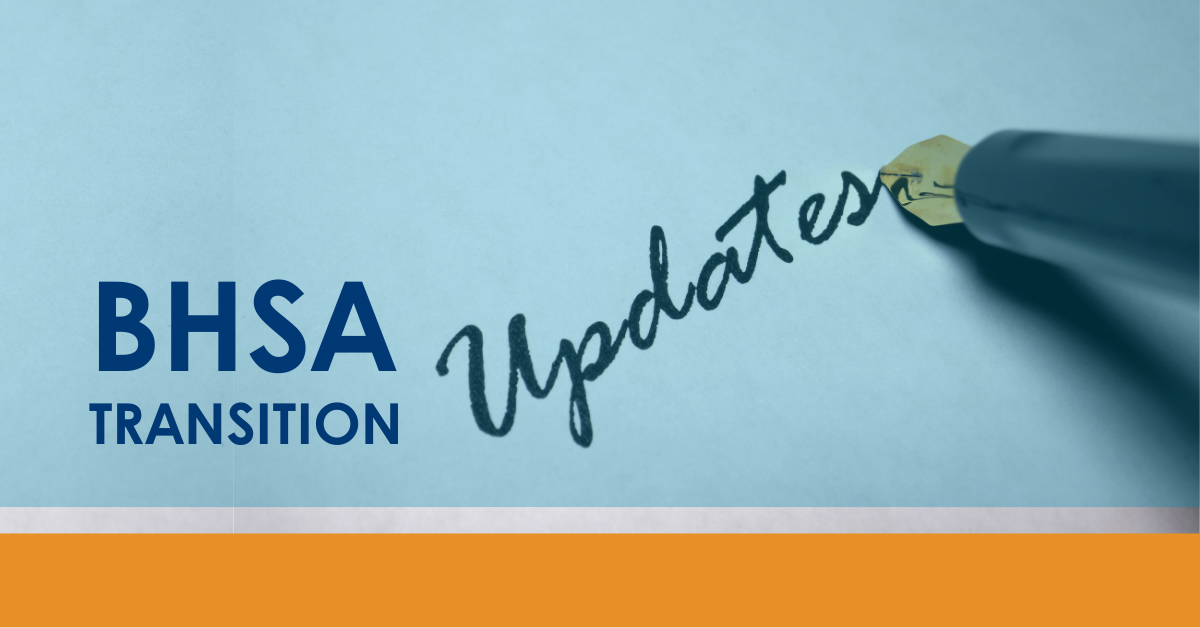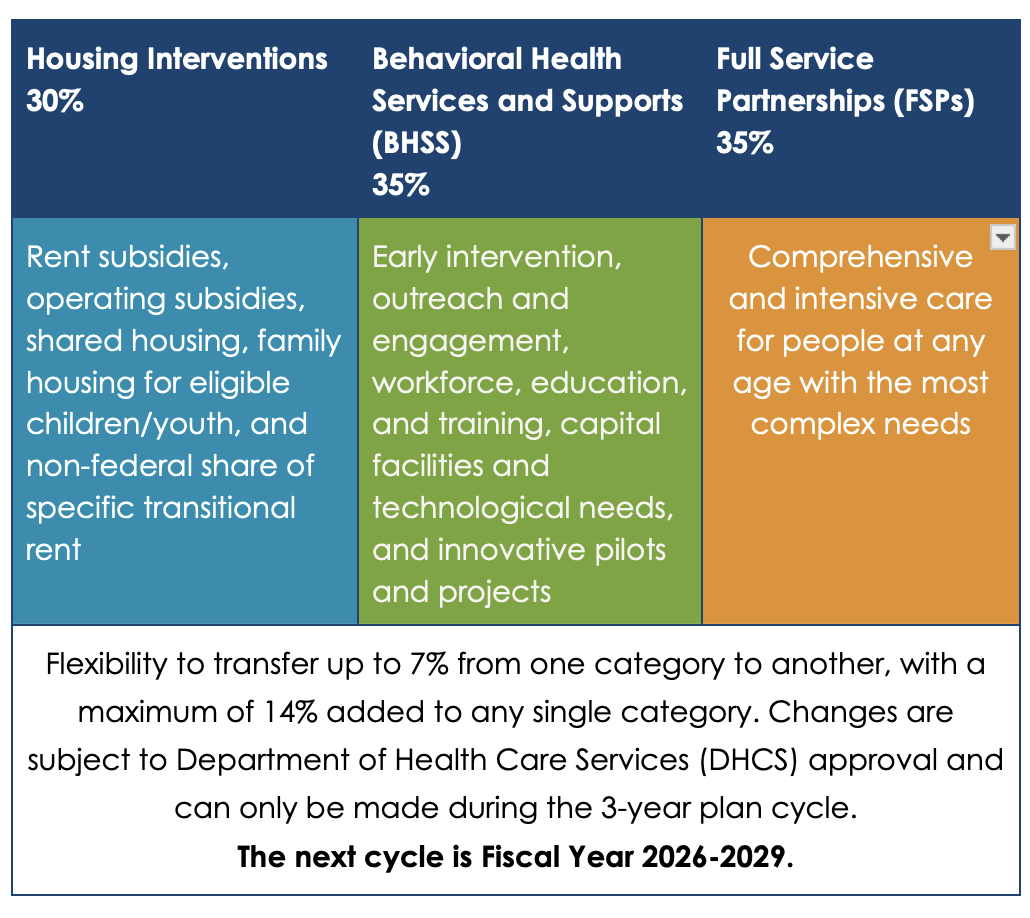California has long been a leader in addressing mental health and housing challenges through innovative funding mechanisms. Since its passage in 2004, the Mental Health Services Act (MHSA) has been a cornerstone of California’s behavioral health strategy. Funded by a 1% tax on incomes exceeding $1 million, the MHSA has provided billions in funding to counties for mental health services, supporting prevention, treatment, and outreach efforts.
EVALCORP has been evaluating MHSA-funded projects across California since 2008. Our expertise encompasses developing countywide MHSA strategic plans, designing and conducting needs assessments to inform MHSA planning and resource allocation, and creating tailored data collection and evaluation systems.
In March 2024, California voters approved Proposition 1, initiating significant reforms to the state’s behavioral health system. This measure introduced the Behavioral Health Services Act (BHSA) to replace the MHSA, with program changes commencing on July 1, 2026. The Act also authorizes a $6.4 billion bond to enhance infrastructure and housing services for individuals with behavioral health needs.
We are committed to supporting our county partners in effectively navigating the transition from the MHSA to the BHSA while also evaluating the ongoing impact of their behavioral health initiatives. We will focus on ensuring these initiatives continue to address the community’s evolving needs.
What is Proposition 1 and the Behavioral Health Services Act (BHSA)?
The BHSA underscores the importance of integrated care models that take a whole-person approach, acknowledging the critical role of social determinants—such as housing stability and community support—in influencing mental health outcomes.
1) The Behavioral Health Services Act (BHSA)
Proposition 1 transitions MHSA into the BHSA, which broadens the scope of services and revises funding priorities:
- Integration of Services: Expands coverage to include substance use disorder (SUD) treatment alongside mental health care.
- Funding Realignment: Shifts the focus toward providing housing and services for individuals with the most acute behavioral health needs, including those experiencing homelessness or at risk of institutionalization.
- Enhanced Oversight: Introduces stricter accountability measures to track the use of funds and program outcomes at the state and county levels.
2) The $6.4 Billion Behavioral Health Bond (BBHB)
Proposition 1 authorizes a bond to finance:
- The construction of new behavioral health treatment facilities.
- The development of supportive and transitional housing units.
- Specialized housing for veterans with behavioral health needs.
What does the transition from MHSA to BHSA mean for Counties?
By replacing MHSA with BHSA, the state aims to address long-standing challenges through integrated services, expanded eligibility, and a stronger focus on housing. The two funding programs are broken down below.

Breakdown of BHSA Funding
The new BHSA funding specifics are detailed below:
The change in funding allocation means that counties may need to shift or redirect some funding for existing programs (funded through MHSA) to other housing-related programs. The funding changes aim to better align resources with evolving community needs and improve integrated care.
For example, the shift towards a more coordinated, state-driven approach could offer opportunities for enhanced collaboration across departments and providers and ensure more comprehensive services for individuals.
What are the key changes made in the transition from MHSA to BHSA?
Housing as a Priority
While MHSA focuses primarily on prevention and treatment, BHSA strongly emphasizes housing interventions as a key strategy for supporting long-term recovery. Under BHSA:
- 30% of each county’s allocation must be directed toward housing solutions for those with the most significant behavioral health needs, particularly those who are experiencing homelessness or at risk of homelessness.
- Half of the above amount must be prioritized for individuals and families experiencing long-term homelessness.
Slightly Expanded Eligibility
BHSA expands planning and reporting to include Substance Use Disorder Services. BHSA funding for housing interventions is available to children, youth, adults, and older adults, similar to the MHSA, but it also includes individuals with substance use disorders.
As mentioned above, 50% of housing intervention funds must be allocated to serve chronically homeless individuals.
What are the reporting and evaluation requirements for BHSA programs?
BHSA has an increased requirement for program reporting:
Community Planning Process (CPP): The CPP has been substantially expanded to improve stakeholder engagement, transparency, and integration with other local planning processes. New The new BHSA CPP requires:
- A wider variety of engagement methods, including listening sessions, surveys, town halls, social media outreach, and virtual participation options (e.g., online meetings, digital comment portals)
- Alignment with Community Health Improvement Plans (CHIPs) developed by Local Health Jurisdictions (LHJs) and Medi-Cal Managed Care Plans(MCPs) Population Needs Assessments (PNAs)
- A mandatory 30-day public comment period for the Integrated Plan (IP) before final submission
- Ability to allocate 5% of annual BHSA revenue for: community planning activities, hiring of staff to coordinate stakeholder engagement, technology for virtual participation, and for training
County Integrated Plan (IP) for Behavioral Health Services and Outcomes: Counties must submit a three-year County Integrated Plan that outlines the use of all public local, state, and federal behavioral health funding, including:
- BHSA
- County realignment (according to Title 3, Division 3, Chapter 6.3 of the Government Code)
- Federal Health and Human Services (HHS), Substance Abuse and Mental Health Services Administration (SAMHSA,) and Projects for Assistance in Transition from Homelessness (PATH) grants
- Opioid settlement funds
- Medi-Cal, California’s Medicaid program, and various departments
The County Integrated Plans must be informed by local stakeholder input and include:
- a budget breakdown of planned expenditures, reserves, and adjustments;
- an overview of alignment with state and local goals and outcome measures; and
- an outline of workforce strategies.
Behavioral Health Outcomes, Accountability, and Transparency Reports (BHOATR): Under the BHSA, Counties must also report annually on all local, state, and federal behavioral health funding expenditures, unspent dollars, service utilization data and outcomes with a health equity lens, workforce metrics, and other information.
As program evaluation and strategic planning experts, EVALCORP is uniquely positioned to help counties navigate these new reporting requirements and ensure compliance with accountability standards. Read more about our community planning and needs assessment services.
What’s next for BHSA?
Funding for Prop 1 is still being allocated, and program initiatives are being developed and communicated to recipients.
Here are a few important dates to know for 2025:
- While programmatic changes will begin July 1, 2026, the community planning process for counties will begin in early 2025.
- In Fall 2024, DHCS opened up a public comment period for the draft Behavioral Health Transformation Policy Manual Module 1. See the results included in the BHSA County Policy Manual Version 1.0 the Policy.
- Homekey+ Notice of Funding Opportunity application portal opens in late January 2025. The California Department of Housing and Community Development (HCD) and the Department of Veterans Affairs (CalVet) announced the availability of approximately $2.145 billion of Homekey+ grant funding, the Behavioral Health Infrastructure Bond Act (BHIBA) Permanent Supportive Housing component.
- Homekey+ will support the development of Permanent Supportive Housing for Veterans and individuals with mental health or substance use disorder challenges who are at risk of or experiencing homelessness.
How EVALCORP Can Assist with the BHSA Transition
EVALCORP has convened a BHSA Compliance and Integration Workgroup dedicated to tracking developments related to BHSA and its reporting requirements.
As California navigates this transition, continuous evaluation and adaptation will be vital to ensure that these reforms meet their goals and effectively serve the state’s most vulnerable populations. EVALCORP’s BHSA Workgroup will continue monitoring updates on new guidelines and requirements. We will keep you informed.


